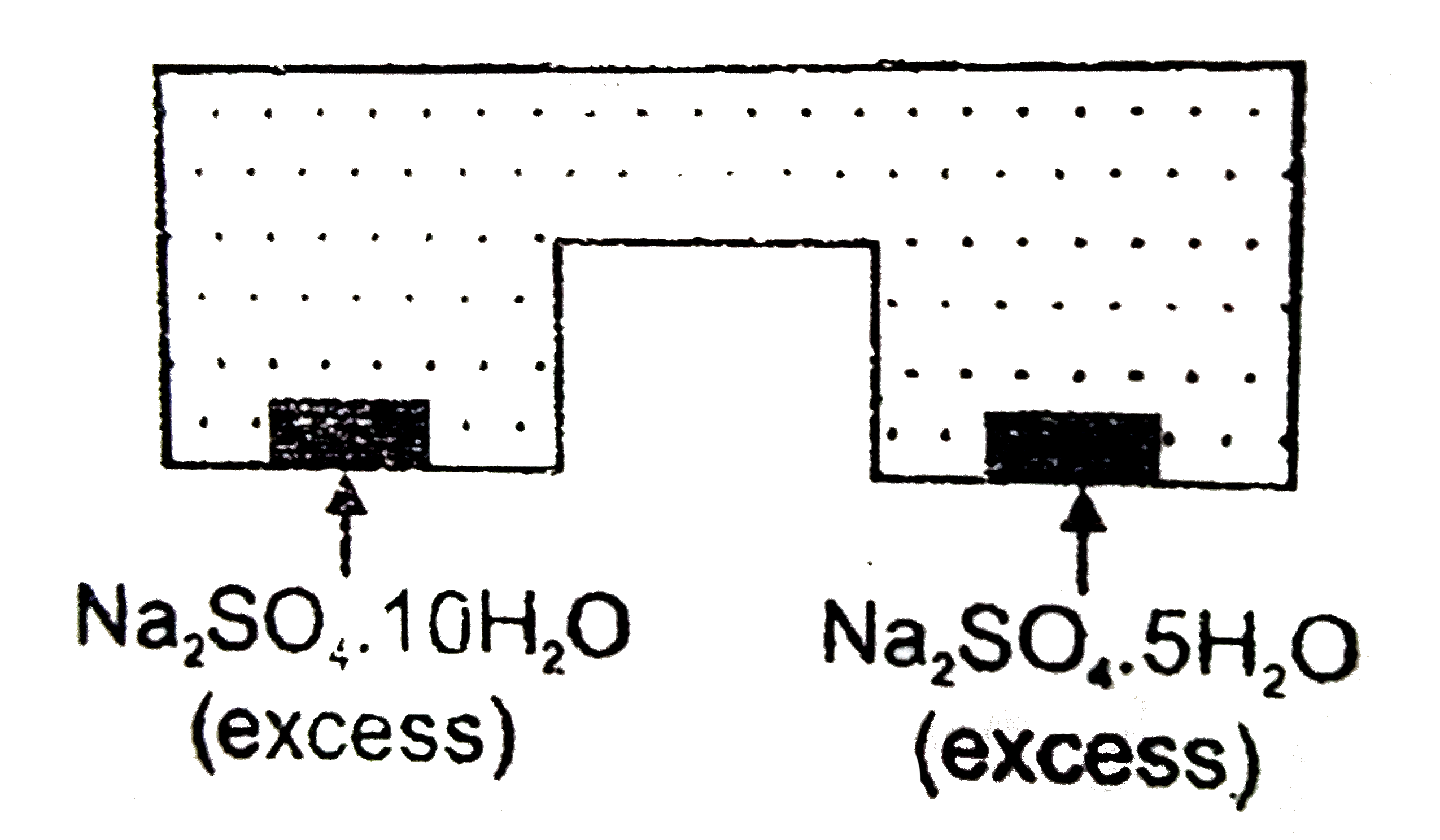CuSO4,5H2O(s)⇔CuSO4(s)+5H2O(g)KP=10−10moles ofCuSO4.5H2O(s) is taken in a 2.5L container at 27∘C then at equilibrium [Take: R=112 litre atm mol−1K−1]
Moles of CuSO4.5H2O left in the container is 9×10−3
Moles of CuSO4.5H2O left in the container is 9.8×10−3
Moles of CuSO4 Left in the container is 10−3
Moles of CuSO4 left in the container is 2×10−4
The correct Answer is:B, D
To solve the problem, we will follow these steps:
Step 1: Understanding the Reaction
The reaction given is:
CuSO4⋅5H2O(s)⇌CuSO4(s)+5H2O(g)
Here, we have solid CuSO4·5H2O on the left, which does not affect the equilibrium constant, and gaseous water on the right.
Step 2: Identify Given Data
- Kp=10−10
- Volume of container = 2.5 L
- Temperature = 27°C = 300 K (after converting to Kelvin)
- R=0.0821L atm K−1mol−1
Step 3: Calculate Δng
The change in the number of moles of gas (Δng) is calculated as follows:
- Moles of gaseous products = 5 (from 5H2O)
- Moles of gaseous reactants = 0 (since there are no gaseous reactants)
Thus,
Δng=5−0=5
Step 4: Relate Kp and Kc
The relationship between Kp and Kc is given by:
Kp=Kc⋅RT⋅Δng
We can rearrange this to find Kc:
Kc=KpRT⋅Δng
Step 5: Calculate Kc
Substituting the values:
Kc=10−10(0.0821)(300)(5)
Calculating the denominator:
R⋅T⋅Δng=0.0821⋅300⋅5=123.15
Now, substituting back:
Kc=10−10123.15≈8.12×10−13
Step 6: Write the Expression for Kc
The equilibrium expression for the reaction is:
Kc=(H2O)51
Thus,
Kc=(H2O)5
Step 7: Calculate the Concentration of H2O
From the expression:
(H2O)5=8.12×10−13
Taking the fifth root:
(H2O)=(8.12×10−13)1/5≈1.65×10−3mol/L
Step 8: Calculate Moles of H2O
Using the concentration to find the total moles in the 2.5 L container:
Moles of H2O=(H2O)×Volume=1.65×10−3mol/L×2.5L=4.125×10−3mol
Step 9: Relate Moles of H2O to CuSO4⋅5H2O
From the stoichiometry of the reaction, 1 mole of CuSO4·5H2O produces 5 moles of H2O. Therefore, the moles of CuSO4·5H2O that reacted to produce this amount of H2O is:
Moles of CuSO4⋅5H2O=4.125×10−35=8.25×10−4
Step 10: Calculate Moles of CuSO4⋅5H2O Remaining
Initially, we had 10−2 moles of CuSO4·5H2O (since it is not specified, we assume it is 0.01 moles). Therefore, the moles remaining at equilibrium are:
Moles remaining=10−2−8.25×10−4=9.175×10−3
Final Answer
The moles of CuSO4·5H2O left in the container at equilibrium is approximately 9.175×10−3 moles.
The reaction given is:
CuSO4⋅5H2O(s)⇌CuSO4(s)+5H2O(g)
Here, we have solid CuSO4·5H2O on the left, which does not affect the equilibrium constant, and gaseous water on the right.
- Kp=10−10
- Volume of container = 2.5 L
- Temperature = 27°C = 300 K (after converting to Kelvin)
- R=0.0821L atm K−1mol−1
The change in the number of moles of gas (Δng) is calculated as follows:
- Moles of gaseous products = 5 (from 5H2O)
- Moles of gaseous reactants = 0 (since there are no gaseous reactants)
Thus,
Δng=5−0=5
The relationship between Kp and Kc is given by:
Kp=Kc⋅RT⋅Δng
We can rearrange this to find Kc:
Kc=KpRT⋅Δng
Substituting the values:
Kc=10−10(0.0821)(300)(5)
Calculating the denominator:
R⋅T⋅Δng=0.0821⋅300⋅5=123.15
Now, substituting back:
Kc=10−10123.15≈8.12×10−13
The equilibrium expression for the reaction is:
Kc=(H2O)51
Thus,
Kc=(H2O)5
From the expression:
(H2O)5=8.12×10−13
Taking the fifth root:
(H2O)=(8.12×10−13)1/5≈1.65×10−3mol/L
Using the concentration to find the total moles in the 2.5 L container:
Moles of H2O=(H2O)×Volume=1.65×10−3mol/L×2.5L=4.125×10−3mol
From the stoichiometry of the reaction, 1 mole of CuSO4·5H2O produces 5 moles of H2O. Therefore, the moles of CuSO4·5H2O that reacted to produce this amount of H2O is:
Moles of CuSO4⋅5H2O=4.125×10−35=8.25×10−4
Initially, we had 10−2 moles of CuSO4·5H2O (since it is not specified, we assume it is 0.01 moles). Therefore, the moles remaining at equilibrium are:
Moles remaining=10−2−8.25×10−4=9.175×10−3
The moles of CuSO4·5H2O left in the container at equilibrium is approximately 9.175×10−3 moles.
Topper's Solved these Questions
- CHEMICAL EQUILIBRIUMBOOK - RESONANCE ENGLISHCHAPTER - CHEMICAL EQUILIBRIUMEXERCISE - Exercise-2 (Part-4)
6 Videos
- CHEMICAL EQUILIBRIUMBOOK - RESONANCE ENGLISHCHAPTER - CHEMICAL EQUILIBRIUMEXERCISE - Exercise-3 (Part-1)
6 Videos
- CHEMICAL EQUILIBRIUMBOOK - RESONANCE ENGLISHCHAPTER - CHEMICAL EQUILIBRIUMEXERCISE - Exercise-2 (Part-2)
22 Videos
- CHEMICAL BONDINGBOOK - RESONANCE ENGLISHCHAPTER - CHEMICAL BONDINGEXERCISE - ORGANIC CHEMISTRY(Fundamental Concept )
6 Videos
- D & F-BLOCK ELEMENTS & THEIR IMPORTANT COMPOUNDS BOOK - RESONANCE ENGLISHCHAPTER - D & F-BLOCK ELEMENTS & THEIR IMPORTANT COMPOUNDS EXERCISE - Match the column
1 Videos
Similar Questions
Knowledge Check
In CuSO4⋅5H2O
Aall the five water molecules act as ligandsBall the five H2O molecules are attached to Cu2+ ionCfour H2O molecules are coordinated to central Cu2+ ion while the fifth H2O molecule is attached to SO2−4 by hydrogen bondsDall the five water molecules occupy interstitial sites in the crystal lattice.
Draw structure CuSO4.5H2O
View SolutionWhen CuSO4.5H2O is heated, what happens ?
View SolutionCuSO4.5H2O(s)⇔CuSO4.3H2O(s)+2H2O(s)KP=0.4×10−3atm2
Which of following sttement are correct:
View SolutionIn CuSO4.5H2O copper is coordinated to
View SolutionExplain the blue colour of CuSO4.5H2O
View Solution
Na2SO4.10H2O(s)⇔Na2SO4.5H2O(g)KP=2.43×10−8 atm^(5) incorrect statement is-
View SolutionThe weight of 1×1022 molecules of CuSO4.5H2O is:
View Solution
